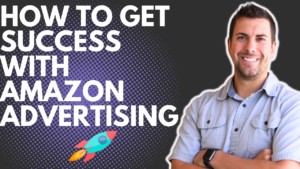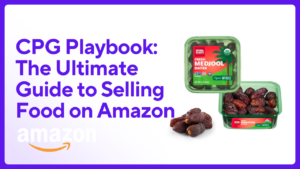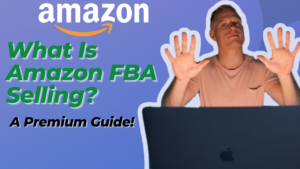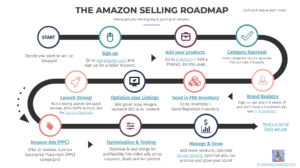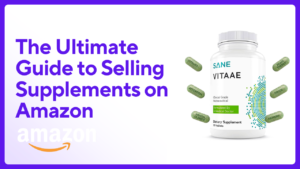If you’re looking to make an impact in the CPG ecommerce market, then selling food on Amazon is a great way to start.
According to data from ECDB, Amazon is the fourth largest ecommerce seller in the food and beverage market, ranking just behind HelloFresh as the favorite to-your-door CPG store in the US.
As an Amazon agency specialized in health & wellness brands, we’ve helped dozens of CPG businesses launch successfully, with niches including healthy snacks, protein bars, supplements, and more.
If you’re planning to launch your own CPG product in the food and beverage niche, you’ll need to build a keen understanding of logistics strategy, content optimization, and how to build momentum for your product after it comes to market.
In this ultimate guide, we’ll walk you through how to sell food on Amazon using our unique launch method, and the tried-and-tested optimizations we use to secure a new seller’s chances of success.
Why Consider CPG / Selling Food on Amazon?
The grocery niche was slow to start in the early days of ecommerce, but more recently it’s exploded. Figures from Statista shows that the current ecommerce grocery customer base is somewhere in the realm of 150 million shoppers, almost half of the US population.
With Amazon’s 2017 acquisition of Whole Foods and an increasing number of brick-and-mortar Amazon stores selling CPG products, it’s clear that Amazon is going to continue positioning itself as a major player for groceries and an attractive alternative to a more traditional shopping experience.
Though this surge in popularity has made for a highly competitive market, there are a number of unique benefits for CPG brands looking at selling food on Amazon, including:
Access to a Huge Customer Base: Amazon is the undisputed king of online retail traffic, with almost 200 million unique users every month.
Nationwide Expansion: If you’ve been building your food and beverage brand with more localized distribution, Amazon could be the perfect way to find new and loyal customers you simply can’t reach through local physical stores.
Target Niche Markets: Amazon’s vast array of product categories and high volume has led to them creating a sophisticated search algorithm that’s great at recognising search intent and matching queries with the right products. This makes it a fantastic platform for catering to a niche market, for example products that are vegan or keto friendly, or formulated for particular allergies.
Health Brand Cross-Selling: If your brand sells multiple health-related products in the CPG market, the Amazon platform lends itself neatly to cross-selling with paid ads, links in A+ content, and brand stores.
How to Get Approved to Sell Food on Amazon
Before you think about your Amazon product launch, you’ll need to make sure your product is suitable for the Amazon platform.
Amazon maintains strict policies on the kinds of CPG products they will and will not sell to ensure buyer safety and protect trust in their brand.
Here’s a breakdown of the key requirements for selling food on Amazon you’ll need to meet before your launch:
Item Packaging
Amazon requires all food and beverage sellers to package their products in a way that ensures they reach customers in an appropriate state. This means avoiding risks like melting, spoiling, or other damage.
With frozen or refrigerated food, for example, you’ll need to maintain an internal temperature to avoid melting and thawing. Other consumable products like chocolate or certain nutritional supplements must also be kept in a controlled environment in-line with Amazon’s policies.
In many cases, your compliance with broader industry regulations like those set out by the FDA will ensure that your product packaging is suitable for Amazon. However, it’s still worth researching Amazon’s own requirements as thoroughly as possible to make sure your current practices are aligned with these.
Shelf Life
When selling food on Amazon, you’ll be required to ship food with enough shelf life that the products can be enjoyed by the end customer. If you’re selling raw produce like fruits or vegetables, you’ll need to ensure that these arrive when they’re ripe.
If you’re looking at selling through Amazon FBA, it’s worth noting that any product you sell must have a minimum remaining shelf life of 90 days when received by Amazon fulfillment. When a perishable product comes within 50 days of its expiration date, Amazon will dispose of it to prevent the risk of it reaching the customer.
There may be other restrictions applying to your product – for example, if your product is classed as meltable then Amazon fulfillment centers will only stock it from October 16 to April 14. It’s crucial to research the policies that may apply to your specific product, and adjust your fulfillment plan accordingly.
Listing Details
Amazon also maintains certain requirements for listings that you’ll need to bear in mind when selling consumable CPG products. These are used to ensure your customers are getting all the most important information on your products when they land on one of your listings.
Some of the requirements include being up-front about dietary claims, e.g vegan, kosher, keto-friendly, and dividing different variety packs into different listings which specify the contents.
Conveniently, these listing requirements are spelled out in Amazon’s own Grocery Style Guide, which all sellers should familiarize themselves with to avoid the risk of listings being disallowed or taken down.
Shipping and Labeling
When looking into how to sell food on amazon, it’s also critical that you understand the relevant shipping and labeling requirements set by the platform.
The labeling requirements are the same as those set for the listing, in that you need to be clear and upfront about what customers are putting into their body. Ingredients, dietary restrictions, and expiration dates must all be clearly visible to anyone looking at your product label.
In terms of shipping, all sellers need to ensure their products have a reliable seal from the outside world. If you’re selling products like protein bars or beef jerky, then your own sealed factory packaging will generally be enough to make sure your products don’t spoil in transit. However, if you’re selling certain CPG products that are heavy on raw fruit or vegetables, you’ll need a double layer of packaging to ensure it’s kept safe from pests and other contaminants.
If you’re planning on selling any products that Amazon classifies as “temperature-controlled” or “raw agricultural commodities”, the Grocery Style Guide has a convenient chart where you can see the required controlling temperature.
Making sure your CPG launch is 100% Amazon compliant can be a challenge, especially when you’re new to the platform. Contact us today to find out how we can advise on compliance and get your launch plan moving!
Package Size Strategy

Launching as a new CPG brand on Amazon means entering a highly competitive niche, full of well-known brands that your target audience will already be familiar with.
In order to gain some sales velocity in the early days of your Amazon product launch, you’ll need to do everything possible to motivate unfamiliar buyers to try your brand out instead of the competitor products that they’re used to.
One of the crucial steps to achieving this is having a solid package size strategy, which means distributing your stock across different product listings in a way that maximizes engagement from new customers.
Here are some of the most effective packaging strategies we’ve used to help CPG brands launch in the past:
Offer Small Sample Sizes
One of the most effective motivations you can use to get potential new customers over the line is to offer your product at a low price. A small “sample” version of your product can help you generate a lot of impulse buys or engagement from customers who already buy your kind of product regularly, and are looking to try something new.
Once they try it, (and love it!) you can quickly generate loyal customers who will order your product again and again.
Create Variety Packs
If you have several flavors or variations of your core product, then offering a selection of these in a variety pack can also be a great way to introduce people to your brand, or encourage new customers to try something different from a newly-discovered brand.
For a totally uninitiated buyer, selling a variety pack can improve the chances that they find a variation they love and come back for more. For those who have tried your core product and liked it, a variety pack could lead them to finding a flavor they can’t get enough of, increasing their lifetime value.
When launching CPG brands, we’ve often found that listing your variety packs as a “bestsellers pack” will generate more clicks and purchases than one that’s simply listed as a “variety pack”.
While a large variety pack selling all your best variations can be a great entry point for new customers, it’s also worth bundling smaller (2-3 products) packs of your most popular varieties, giving people who already like one of your products a route into discovering more.
Offer “Family Size” Value Packs
Creating a listing with a large quantity of products in a “family size” value pack can be a highly effective way to keep satisfied customers coming back.
The promise of greater value by buying in bulk can effectively turn one-off buyers into subscribers, allowing you to move products in greater volumes, save on shipping, and maximize your profit margins.
Having said that, some sellers may find it useful to start off with smaller packages and plan to launch value packs later. This allows you to gather data on which of your product varieties are the most successful on Amazon, and avoids the risk of wasting fulfillment budget on stock that may not get a lot of sales.
Selling Food on Amazon: Launch for Success
With the assurance that your products are approved for Amazon, you’ll be ready to set up your seller account, build an engaging listing, and begin marketing your brand aggressively to start getting sales.
Here, we’ll walk you through the phases of our tried and tested launch method for launching new CPG products with the maximum chance of success.
Setup: Getting Started

The first phase of our process is setting up on Seller Central and meeting the prerequisites to create and publish a listing. To do this, you’ll need to complete the following steps:
- Create a Seller Account. Visit Seller Central, click “Create your Amazon Account”, and following the instructions using your business information.
- Apply to un-gate your category. Some common CPG categories include food & beverage, chilled and frozen food, and organic products. Un-gating your category will require you to submit certain documentation and proof of the products you’re going to sell.
- Submit a distributor invoice. This must be no more than 180 days old, and show that you’ve purchased at least 10 of the products you’re planning to sell.
- Upload high-quality, unedited images of your product in its original packaging.
- Get brand registry. Though this isn’t strictly necessary to start selling, you’ll need it to create high-quality listings with content that converts.
Appearance: Creating Great Listings

Even when you’ve got a great product, you’re not going to be able to generate sales on Amazon unless you frame it with a great listing.
This means writing a compelling product description that’s informed by quality keyword research, and high-quality, informative visual content that measures up to competitor branding.
Let’s look at some of our best practices for optimizing each element of your listing, and how you can frame your product in a way that will maximize conversions.
Listing Copy
Your listing copy covers the titles, bullet points, and longer product description displayed on your product listing page.
Like Google, amazon’s search function is powered by an algorithm that uses keywords and user engagement signals to serve the most relevant results to a user’s query. With this in mind, it’s good practice to use an Amazon keyword research tool like Merchantwords or Jungle Scout to analyze the terms shoppers are using to find products like yours, and include these terms naturally in the crawlable text (the text that Amazon’s bots will pick up) of your product listings.
Note that each of the editable text fields on your listings will have a certain character limit that Amazon will stop crawling at, and it’s important to ensure that any targeted keywords are included within these crawlable limits to optimize your listings for better rankings.
Here are the character limits to be aware of when you come to planning and writing your product listing copy:
- Title: 200 characters.
- Bullet points: 1,000 characters.
- Product description: 2,000 characters.
- Backend keywords: 250 characters.
Here are a few key best practices to bear in mind when writing your listing copy:
- Use every available character of your title to include your most compelling USPs and give your target audience a reason to click. Aside from the raw traffic this will bring to your listing, click-through-rate on specific terms is a major ranking factor in Amazon’s A10 algorithm, and will improve your organic rankings over time.
- Though bullet points can be a maximum of 500 characters each, Amazon’s bots will stop crawling them after 1,000 characters total. With this in mind, it’s important that you include any targeted keywords in the first 1,000 characters.
- Effective bullets link every product feature with a clear benefit, e.g “OMEGA GOODNESS: These gourmet nuts are selected for a high concentration of Omega-3 and Omega-6 healthy fats”.
- Amazon’s algorithm doesn’t rank by keyword density, so once you’ve included a target term in the title, bullets or product description, there’s no benefit in repeating it in the backend keywords, and this will only waste precious characters.
Images
The quality of your Amazon listing images are a huge predictor of your listing conversion rate, and it’s crucial to get this part right.
Some of the Amazon images best practices we recommend when launching CPG brands include:
- Invest as much as possible in quality photography and graphic design. Branding is hugely important for food and beverage products, and you’ll need to ensure the quality of yours measures up to or exceeds your close competitors.
- Choose lifestyle images that match your product’s USPs. If it’s a health-boosting protein bar, show it being enjoyed on a tennis court or in a gym. If it’s hand-crafted chocolate, show it being enjoyed on a sofa.
- Use copy overlays and infographic-style images to emphasize the features and benefits.
- Images must be at least 1000 pixels on the longest side for users to zoom in, and should have a square 1:1 aspect ratio.
- Ensure all images are high-resolution with large, easy-to-read text to ensure they’re accessible for mobile users.
A+ Content
A+ content is the text and visuals that appear under your main listing and the related products carousel. Aside from being a positive ranking factor, A+ content gives you space to build a better shopping experience by delving further into product details and emphasizing the benefits of your product.
Here are some of the A+ content best practices we apply when launching a new CPG brand:
- Emphasize any particular dietary niches that your CPG product is catered to, e.g vegan-friendly, keto-friendly, sustainable packaging.
- Tell the story behind your brand and the philosophy you use to manufacture your CPG product. It can be hard to convince someone to buy an unfamiliar food or beverage product, and this extra sense of your brand persona can motivate shoppers to choose you over more well-known brands.
- Show your products using different angles, plating, and lighting that hasn’t been used in the listing images to help your target market get a clearer idea of what they’re buying.
- Keep a consistent color scheme and theme throughout the content that clearly exhibits your product’s USPs and your brand’s unique identity.
- Use the text fields to address FAQs which you haven’t covered in the copy.
- Use the comparison chart module to showcase your other products and drive traffic to complementary listings.
Premium A+ Content
Premium A+ content is an advanced version of the A+ content feature, which allows you to add additional types of visual content such as videos, image carousels, shoppable images, and more.
We recommend unlocking it at the earliest possible juncture and using its features to boost engagement with your listings.
You can unlock premium A+ content by:
- Having 15 regular A+ content approvals in the last 12 months. If you don’t have 15 separate ASINs, you can make small edits, submit, wait for approval and then repeat 15 times.
- Having Brand Story activated for all ASINs
The quality of your listing content can make or break your product’s profitability. Get in touch today and find out how we can help you ensure your content is top-quality and maximize conversions for your listing.
Launch: Bringing Your CPG Product to Market
With your account set up and a great listing in place, you’ll be ready to start actually selling food on Amazon.
A successful CPG Amazon product launch calls for the right approach to a few different aspects, including pricing, offers, and generating a buzz with reviews and user generated content.
Here are some of the best practices we use to help our CPG clients get their product launch right and start building sales from day one.
Use and Optimize Subscribe and Save
Subscribe and save is an Amazon feature that allows shoppers to automate their purchases of a product they’ve enjoyed at a discount, and can be a great way for sellers to move consumable products at greater volumes.
This feature will automatically turn on once you reach a certain sales velocity and in-stock rate, and sellers can adjust the discount they offer to customers.
We recommend most of our CPG customers offer a subscribe & save discount of 15-20%, or, if you’re planning for an especially aggressive launch, 20-25%.
Continually Test Pricing and Discounts
Like with any ecommerce market, having a low price on Amazon will improve conversions but reduce your margins, while a higher price will have the inverse effect.
To find the sweet spot where you’re maximizing both your sales volume and conversion rate as much as possible, we always urge our clients to continually split test different price points and discounts. The ultimate aim here is to get your listing to a point where your audience recognises it as a high-value offer and maximizes your sales volume.
Maintain a High FBA Inventory
Food and beverage, as well as other high-LTV products like supplements, tend to move in high volumes once you find your first few satisfied customers.
When new sellers start gaining traction, it can be a common issue for them to run out of stock. This will lead to the product listings being penalized by the algorithm, and will make it harder for you to benefit from organic visibility.
Though it can be tempting to keep a cap on fulfillment costs as a new brand, it’s important to maintain a high inventory, show Amazon that you can keep up with a potential spike in sales, and set a firm baseline for your organic rankings.
Stimulate Positive Reviews and UGC
Social proof can be a huge boost to any CPG brand, and it’s important to start building positive product reviews as much as possible after your launch.
Some of our favorite techniques for this include:
- Using a product insert card tool like getreviews.ai to offer new customers discounts or free products, while making it quick and easy for them to share feedback and post their reviews to Amazon.
- Network with micro-influencers or use platforms like thesocialcat and Billo.app to send out free products and get your brand in front of a wider following.
- Use Amazon’s own Vine program to send free products to active reviewers in exchange for impartial reviews on your listing.
Start with an Aggressive Ad Strategy

Across all our CPG clients, we always recommend that you start your Amazon PPC strategy aggressively with a budget of at least $100 a day, and continually test different keywords and ad copy.
Keeping a close eye on your TACoS (total advertising cost of sale), you’ll soon be able to hone in on the most profitable bids and ad designs, and generate a healthy sales volume in your first year.
Some of our best practices for a PPC strategy at launch are:
- In general, we put in a $100/day budget to start testing & gathering data, then adjust twice a week. Depending on CPCs and how competitive your target keywords are, you will know to raise or lower it.
- Test, test, and test some more. It’s the only sure-fire way to find the most effective strategy for your ads.
- Invest in the following ad types:
Sponsored Video Ads – test at least 3 videos with 3 different beginnings each. Use large on screen words that explain as simply as possible why you’re unique & better.
Competitor Targeting Ads
Brand Headline Ads
- In launch & rank phase, you want to keep TACOS as high as you can. Basically the more you spend, the more sales you’ll get, thus the faster and higher you’ll rank.
- Aim for a TACoS in your profit optimzation phase of 10-20%
- Remember that many Amazon-savvy brands aim for the break-even point the first year. The first year of selling food on Amazon is more about building reviews and organic ranking. Then in year 2-3+, optimize for profitability by testing pricing, spend, and placements.
Selling Food on Amazon the Right Way
Selling food on Amazon means taking a bite out of a highly competitive niche, but using a tried and tested approach to compliance, listing optimization, and maintaining velocity after launch, you’ll be able to get your CPG product off to the right start and maximize your chances of a successful first year.
Selling Food on Amazon Frequently Asked Questions
Can you sell food on Amazon?
Short answer: yes! Amazon has a thriving grocery sector, with countless CPG brands selling in high volumes through the platform. Though it lends itself more naturally to non-perishable food products, more basic agricultural produce like raw meat and vegetables are also sold widely on Amazon.
Can you sell food on amazon FBA?
FBA is a very popular method for CPG businesses looking to bring their products to Amazon, allowing sellers to take advantage of Amazon’s well-established logistics network and the vast storage capacity of their fulfilment centers. However, there are certain FBA restrictions which may make an FBM model more viable, for example only being able to stock meltable items in Amazon fulfillment centers from October 16 to April 14.
Do you need a license to sell food on Amazon?
While your business will need to comply with state cottage food laws or commercial kitchen regulations, there’s no licensing requirements that are specific to Amazon. However, Amazon maintains its own food selling policies you’ll need to adhere to, covering aspects like item packaging, shelf life, listing details, and labeling your products.
What should I be aiming for?
When launching CPG brands on Amazon, we always work towards a measurable target we call “The North Star”.
This is a listing with 1000+ reviews with a 4.3+ rating. This will cause an upward spiral in sales & conversion rate. From there, you’ll have a pretty solid position on page 1 for potentially years to come. This is a grand slam on Amazon and where the big bucks are made.
How Much Can I Make?
The amount of revenue you generate through Amazon will depend on several variables, including the quality of your product, how well you optimize your listing, and other factors. For reference though, here’s a few figures from CPG brands that we’ve helped in the past:
Example market: on page 1 for ‘protein bar’
- IQBAR: 40,000+ units, $1,000,000+ monthly
- Quest Bar: 150,000+ units, $3,000,000+ monthly
- Four products do 7-figures, many do multi 6-figures.

